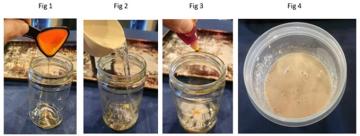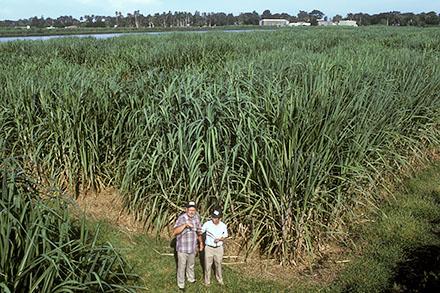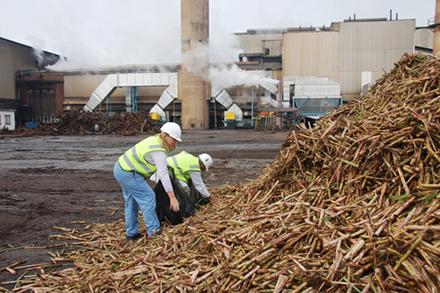Take the Apple Seed Challenge
Do different types of apples have the same number of seeds? Join student and future scientist Lexlyn Cravens of the Chesapeake Math and IT Elementary School in Laurel, MD, to find out. Let's get counting!
Do different types of apples have the same number of seeds? Join student and future scientist Lexlyn Cravens of the Chesapeake Math and IT Elementary School in Laurel, MD, to find out. Let's get counting!

The Chesapeake Bay is the largest and most productive estuary in the United States and third largest in the world. Approximately half the water in the Bay comes from its 64,000 square mile watershed. A watershed is an area of land that can contribute water into a stream, river, lake, or bay. The Chesapeake Bay's watershed includes land in all or part of six states, from New York to Virginia. That's a lot of land, and as you can imagine over time urban development, agriculture, and industrialization in those areas have affected the water quality of the Bay's watershed.
The Bay has regional, national, and global importance—providing food sources, recreational opportunities, and access to major shipping routes. It is vitally important to protect it from the harmful effects of pollution and climate change. ARS scientists are conducting research to better understand the Bay's ecosystem (e.g., water quality, soil health, wildlife habitat, food production). This will benefit not only the United States, but also conservation efforts in the other global estuaries, like the Baltic Sea.
You can learn more in "Improving the Water Quality of the Chesapeake Bay".

ARS entomologist Elaine Backus is improving our understanding of how mosquitoes feed. Using a technique known as electropenetrography (EPG), Backus attaches an electrode to both a human host and a mosquito. When the mosquito bites, a circuit forms, allowing researchers to measure all kinds of information about the bite, from how long it lasts and what the stages are to differences between male and female mosquitoes’ bites.
Although the technique was originally developed to examine how pests feed on crop plants, Backus and her colleagues expanded it to understand blood-sucking insects, including mosquitoes, ticks, and more. They hope that their research will aid in the fight against the negative effects of mosquito bites, from itchy irritation to disease transmission. Watch this video to learn more about their work.

Cotton is biodegradable, while synthetic fibers contribute to pollution
Nonwoven textiles are made from loose fibers in a high-speed process. They are mostly used for single-use disposable products such as wipes, diapers, disposable masks, bandages, and surgical gowns. A research team at the ARS Southern Regional Research Center in New Orleans, LA, is looking at ways to increase the use and utility of cotton fibers.
Cotton accounted for less than 7% of the fibers used in nonwoven products, while synthetic and other fibers comprised the rest. The problem is that synthetic fibers, like polyester and polypropylene (which are, essentially, plastics), persist in the environment for decades and contribute to pollution, especially in marine environments.
Consumers recognize this as an environmental hazard and are seeking greener, sustainable, and biodegradable products. Farmers, producers, and consumers benefit from a natural and sustainable product and the environment benefits from less plastic pollution.
Read "Improving the Sustainability and Value of Cotton’s Natural Fibers" if you want to learn more.
Scientists use hydrogen peroxide to sanitize and clean surfaces in their labs. One of the reasons we use hydrogen peroxide is because it does not leave any residue. Once exposed to UV light/the sun it breaks down into oxygen and water. This is also why bottles of hydrogen peroxide come in dark opaque bottles. This reaction happens slowly over time. However, we can make this happen more rapidly with a catalyst. Yeast is an organism that we use to make bread and test different strains of wheat in our wheat quality laboratories. Yeast produces such a catalyst that breaks down hydrogen peroxide. This is the same enzyme/catalyst that causes the peroxide to bubble when we put it on a cut or scrape. Catalase is present in most living things that have access to oxygen and helps them break down naturally occurring hydrogen peroxide.
 About the Experiment
About the ExperimentFor this experiment, we're going to find out. What happens if we put hydrogen peroxide and yeast together in a large quantity? What if we added dish soap and food coloring? How does that change the outcome? It's time to get your hands messy like a scientist!
 |
Details
|
 |
|
 |
|
 What You'll Need
What You'll Need
Before you begin: Ask a parent or adult to assist. This is a fun but messy experiment, so you may want to consider doing it outside. However, it can be done in a kitchen or bathroom. Be careful with the ingredients, as hydrogen peroxide can bleach fabrics and food coloring can stain clothing. Wear clothing that you don't mind getting "dirty" or wear an apron or lab coat!
 Let's Do This!
Let's Do This!
7. Quickly pour the yeast mixture into the vessel and step back and watch!

Let's Look At The Results!
Clean up:
The end-result that looks like toothpaste is safe to wash down the drain with water or put in the trash. If you got any toothpaste on your clothes or skin, rinse in cool water. The bottle/vessel and measuring tools can be cleaned with warm soapy water or placed in a dishwasher.
What did you learn?
Additional experiments:
Try doubling the recipe or using half the dish soap. Use more or less food coloring, and either shake it vigorously or do not shake at all.
How do these modifications affect the outcomes?
Pests are a major problem for our food growers, causing millions in damage and lost products. Nematodes – these tiny worm-looking things that feed on the root of plants – can be especially troublesome for organic farmers because pesticides are often the most effective way to manage these pests. However, ARS researchers found an effective, organic treatment against nematodes and other pests that uses orchard grass.
Read Killing the Crop Killers—Organically to learn more.

The United States began honoring women’s history in 1980, but ARS has a long tradition of celebrating the role of women in science. Women have been leading cutting-edge scientific research for decades, and many have been enshrined in the ARS Science Hall of Fame.
Here are just a few examples of current women working in ARS projects:
Beth Newingham is a research ecologist at the ARS Great Basin Rangelands Research unit in Reno, NV. Newingham is studying rangeland restoration after wildfires in the Great Basin.
Tracy Leskey, entomologist and director of the ARS Appalachian Fruit Research Station in Kearneysville, WV, is leading research into controlling the invasive brown marmorated stink bug, a major pest of many key crops.
Soheila Maleki is a research chemist with the ARS Food Processing and Sensory Quality Research unit in New Orleans, LA. She is searching for a treatment for peanut and tree nut allergies.
Revathi Shanmugasundaram is a biologist at the ARS Toxicology and Mycotoxin Research unit in Athens, GA. Shanmugasundaram is conducting research into whether mycotoxins in poultry feed could predispose chickens to fatal disease, even at low levels.
Hannah Rivedal is a plant pathologist at the ARS Forage Seed and Cereal Research unit in Corvallis, OR. She is working with scientists at Oregon State University and other institutions to help growers fight diseases of hemp and mitigate the damage they cause.
Emily Watkins de Jong is a biological technician conducting research into honeybee nutrition and health at the Carl Hayden Bee Research Center in Tucson, AZ.

Bananas Foster, beignets, pralines, and king cake are classic desserts in Louisiana, and the thing that ties them together is sugar. Lots of sugar. As it turns out, sugar’s origins are just as wild as you might expect for a plant that grows in the land of Mardi Gras; sugarcane, the most famous source of sugar, is a weedy grass.
Louisiana is unique among sugarcane-producing areas because its “weeds” come from more than one species. That’s a good thing because scientists at the Agricultural Research Service’s (ARS) Sugarcane Research unit in Houma, LA, use genetics to breed new varieties every 13 years or so to stay one step ahead of pests and diseases and promote other beneficial traits.
In this case, sugarcane variety HoCP14-885 features disease-resistance, the ability to withstand freezing temperatures, and contain greater sugar content — which allows the industry to produce sugar in half the time it takes many other countries. The ARS scientists can trace the pedigree of HoCP14-885 back 16 generations to the late 1800s.
Sugarcane is big business in Louisiana; the crop is grown on 480,000 acres, employs 19,000 people, and has an annual value of over $2.3 billion.
Grasslands play a pivotal role in the American landscape, providing forage for livestock, and also serving as one of the most effective means to sequester carbon in the soil. However, ARS researchers have discovered that the condition of that soil dramatically affects how well grasslands can perform these functions. Over five years, the researchers simulated future atmospheric conditions by raising CO2 and temperature levels in dedicated plots of grassland. Some plots were intact, populated by native plants, while others were characterized by soil disturbance – the kind of disruption caused by practices like tillage.
One of the most dramatic discoveries of the researchers’ study was the extent to which invasive plants took hold in areas where the soil was disturbed. The unpalatable invasive plants – those that animals can’t or won’t eat – spread profusely in the disturbed patches of land, crowding out other plants and reducing overall biodiversity. Intact plots of land, by contrast, saw much greater biodiversity, and responded with more resilience to the changed environmental conditions, retaining the ability to sequester carbon in the soil more effectively. The results provide guidance both for researchers who want to more accurately predict how different regions will respond to changing climate conditions, and for farmers, ranchers and other managers to better understand how their choices affect the land they steward.
Read "Soil Disturbance Reduces Resilience of Rangelands to Climate Change," and the original study is available online.

The average American consumes 17 teaspoons of sugar per day. It takes a lot of raw material to create all that sweetness, but there is a downside – what do you do with all the leftover sugarcane processing waste?
Scientists with the Agricultural Research Service’s (ARS) Southern Regional Research Center (SRRC), in New Orleans, LA, are turning that waste into products that can refresh the soil. Two examples involve mill mud and bagasse.
Mill mud is an enriched sludge that is full of organic carbon, nitrogen, and nutrient minerals. The mud can help restore fertility to sandy soil and land affected by erosion or biomass burning.
Bagasse, the rest of the sugarcane plant once the sugar is removed, can be an inexpensive component of fuel, paper, particle board, mulch, and roughage feed for herds. Bagasse is also a natural filter to remove organic and metal contaminants from water.
Read "Sweetening the Deal" to learn more.